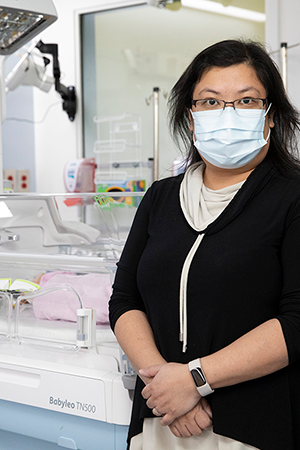Blood sugar levels in newborns may predict likelihood of brain injury
Summary:
A SickKids research team has linked high blood sugar levels in the first 48 hours of life with brain injury in infants with neonatal encephalopathy.
More than half of babies with neonatal encephalopathy (NE), a condition caused by inadequate blood flow to the baby, have excessively high blood sugar levels. Now, a research team at The Hospital for Sick Children (SickKids) has identified a potential biomarker using blood sugar levels that could be used one day to predict risk of brain injury after NE.
The research study, led by Dr. Emily Tam, Staff Physician and Senior Associate Scientist in the Neurosciences & Mental Health program, examined the impact of blood sugar levels on brain injury in infants after NE, using a cohort of 102 babies with NE at SickKids. The study, published in eClinicalMedicine, found that in the first 48 hours of life, a blood sugar concentration over 10.1 mmol/L may predict brain injury after NE and be associated with an increased risk of a diagnosis of cerebral palsy, severe disability and death.
“Our research is the first of its kind to examine the relationship between high blood sugar levels and brain injury after NE," says Tam. “We hope that this will inform potential clinical trials to help control maximum glucose concentrations and improve outcomes for infants with NE.”
On the publication of these findings, Tam shares some insights on the significance of these findings and the important role of patients and families in research.
How did you uncover this relationship between blood sugar levels and brain injury?

The strength of this study is the innovative use of the continuous glucose monitors developed for use in patients with diabetes to obtain detailed measurement of a newborn’s sugar levels. We were able to closely monitor changes in blood sugar levels over the course of the first three days of a newborn’s life, to identify the most predictive severity and duration of high blood sugar, as well as the time window of monitoring, to provide the most powerful predictor.
What is the significance of these findings for patients and families?
While it has been generally known in other patient groups that high blood sugars result in worse brain outcomes, this has not been previously clearly delineated in newborns. Information about what sugar levels are associated with brain injury will be very helpful to clinicians taking care of these newborns in our neonatal intensive care units (NICUs), as we continue to build on this research through future studies. Knowing this association, detection of high blood sugar levels could be used to potentially alert clinicians at the bedside to raise their concern regarding the baby’s risk for brain injury.
We also found that there was a relationship between severity and duration of high blood sugar associated with brain injury. We hope that this can translate to simple management guidelines in the future to improve outcomes after neonatal encephalopathy.
One of the challenges to research is recruiting participants. How did you recruit and engage with patients and families during this research?
Enrolling sick newborns within a few hours of life is exceedingly difficult and is a daunting decision for new parents who have just been informed of their newborn’s unexpected illness.
We had the excellent fortune to have had the opportunity to work with the SickKids Acute Care Transport Service (ACTS) team, an amazing group of clinicians who help stabilize and transport these babies to our NICU. The ACTS team played such a key role in early and compassionate interactions with the families to enable the families to understand the importance of participating in research, making this study possible.
What are the next steps for this research?
We are so grateful for the families who agreed to participate in this study and have so diligently returned to SickKids for ongoing follow-up assessments. We are continuing to follow the study participants to five years of age to better understand the long-term outcomes of high blood sugar in the newborn period.
The data from this study has already provided us critical information on how NE and non-typical blood sugar levels manifest in both early brain function and brain injury patterns. We look forward to further studies to definitively determine if keeping blood sugar levels under 10.1 mmol/L in these newborns can result in less brain injury and better long-term outcomes.
This study was funded by the Canadian Institutes of Health Research (CIHR), the U.S. National Institutes of Health (NIH), and the SickKids Foundation. Continuous glucose monitors were provided for research use by Medtronic Canada.

